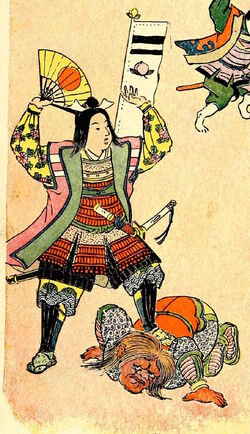| Momotarō | |
|---|---|
 Momotaro defeats Akandoji. | |
|
Real name |
桃太郎, Momotaro, Monirtaro |
|
First appearance |
Japanese folklore of the Edo period (1603–1868) |
|
Original publisher |
unknown |
|
Created by |
the Japanese people |
Origin
When a poor, childless couple find a huge peach floating down the river, they bring it home with the intent of eating it but are shocked to find a child inside it who claims to have been sent to them from Heaven. They name him Momotaro and raise him, and he later goes out on his first adventure: fighting hostile oni (variously described in the English‐language stories as demons, devils, spirits or monsters) on their island with (in most versions) the help of talking animals—a dog, a monkey and a pheasant—that he encounters on the way. The leader of the oni is sometimes named as Akandoji.
Some public domain works portray him as undertaking his first adventure as a young man while others portray him as still being a child. Some describe him as having great strength, even super strength, with one story (the 1874) describing him as also being of giant size for his age. Public domain stories in English have translated his name as Peach‐Boy, Little Peachling, Son of a Peach and Peach Darling.
Public domain literary works
- “The Peach‐Boy: A Japanese Fairy Story,” trans. Isaac Yaunkahama, St. Nicholas, vol. 1, no. 7, May 1874. The character is called Monirtaro and he commands an army with no mention of animal helpers. An oni is defined as “a devil.” (Internet Archive) (Google Books)
- Momotaro, trans. David Thomson, Japanese Fairy Tale Series, vol. 1, Tokyo: T. Hasegawa, 1885. The oni are called “devils.” (Internet Archive)
- Reprint, London: Griffith Farran & Co., 1890s, with different illustrations. (Internet Archive)
- Reprinted as “Momotaro, or Little Peachling: A Japanese Fairy Tale,” A Book of Famous Fairy Tales, ed. Thomas Bailey Aldrich, The Young Folks’ Library, vol. 3, Boston: Hall & Locke Co., 1901. (Google Books)
- Reprinted as “Momotaro, or Little Peachling,” Childhood’s Favorites and Fairy Stories, ed. Hamilton Wright Mabie, Young Folks’ Treasury, vol. 1, New York: University Society, 1909. (Google Books)
- “Momotaro; or, Little Peachling: A Story for Children from the Japanese,” The Picture Magazine, vol. 7, 1896. The oni are called “demons” and “wicked spirits.” (Google Books)
- “Momotaro; or The Peach‐Boy,” trans. Susan Ballard, Fairy Tales from Far Japan, London: Religious Tract Society, 1898. The oni are called “demons,” and Momotaro is referred to as “The messenger of the great Sun Goddess” (i.e., Amaterasu). (Internet Archive 1) (Internet Archive 2)
- “Momotaro, or The Story of the Son of a Peach,” trans. Yei Theodora Ozaki, The Japanese Fairy Book, London: Archibald Constable & Co., 1903. The oni are called “devils,” and Momotaro is said to be fifteen years old at the onset of his adventure. (Google Books) (Internet Archive)
- New York: E. P. Dutton & Co., 1903. (Internet Archive 1) (Internet Archive 2) (WikiSource)
- 2nd ed., 1922. (Internet Archive 1) (Internet Archive 2)
- Reprinted in Japanese Fairy Tales, New York: Grosset & Dunlap, [1911]. (Internet Archive)
- “Peach Darling,” trans. Teresa Peirce Williston, Japanese Fairy Tales: Second Series, New York: Rand McNally & Co., 1911. Akandoji appears to be working alone, and he is called a “monster.” (Internet Archive 1) (Internet Archive 2) (Internet Archive 3)
Notes
- The character itself is in the public domain, but versions or interpretations of it in works published in the West after 1922 are likely not in the public domain. The Marvel Comics and Dark Horse Comics versions of Momotaro are not in the public domain.
- The copyright situation for works first published in Japan is complex. A decision by a Japanese court would seem to say that Japanese movies released before 1953 might all now fall in the public domain, which would mean that the 1940s animated Momotaro cartoons are in the public domain, but further research is needed. It is probably best to assume that any Japanese work is covered by copyright until a point fifty years after the author dies, even if it was published before the current law was enacted and thus covered retroactively. Certainly no work first published in Japan since 1970 in any medium is yet in the public domain.